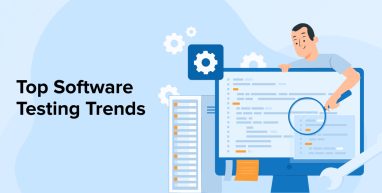
When it comes to the software testing ecosystem, within the last few years, there has been a great change in it as new trends and technologies have been coming into the IT industry services that have brought the latest updates in any development company that carries out software designing, development, testing, and deployment processes. But out of all the phases carried out in the SDLC, the most crucial phase is testing as it makes sure that the developed software is safe and secured. This is why businesses who want to hire a development team for their project prefer to have a team that has excellent testing personnel who follow the latest software testing trends and approaches before delivering the product.
But with this, the top priority of businesses is cost optimization and this is why while offering digital transformation to the businesses, the IT leaders and software testing services providers believe in the integration of the latest IT techniques.
Therefore, nowadays, companies have started integrating their testing in earlier phases of the SDLC process with the help of methods like DevOps and Agile. This approach enables the testing team to carry out test coverage, artificial intelligence, machine learning, robotic process automation, and other various latest testing concepts in securing the software. In this way, the software testing team can offer the best software to the clients.
To know more about software testing trends for the year 2022, let’s go through this blog and see which trends have come into the market recently and how companies are using them to deliver the best products to their clients.
1. Top Software Testing Trends
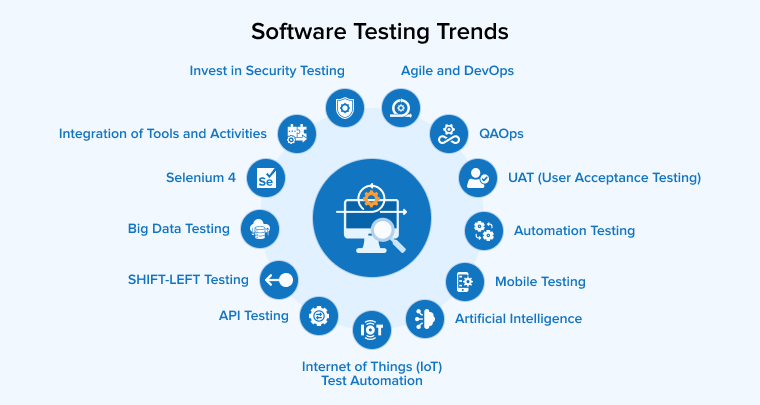
Here are some of the most latest software testing trends for the year 2022:
1.1 Agile and DevOps
Nowadays, the demand for faster software development lifecycle (SDLC), small autonomous teams, and quicker releases of products has increased and this has made agile software development a popular process. Agile is a concept that improves collaboration among specific methodologies and various teams. With the help of agile methodologies, software developers can create tailored products to meet the project’s demands.
Some of the major reasons behind companies moving towards agile are continuous integration, faster delivery, and more frequent deployments that eventually help in satisfying customers with higher quality products. For this, the agile software testing process is the key part. It enables the testers to quickly check the software and its quality which is helpful for getting end-user feedback at the earlier stage of SDLC and making changes if necessary.
On the other hand, DevOps is one of the trends in software testing that is all about automating and streamlining the entire software testing landscape involved in SDLC. The main factor involved in DevOps testing is the adoption of agile testing best practices and following techniques like continuous integration to ensure a better quality of the product.
The involvement of both Agile and DevOps processes in the testing practices always comes up with an idea of shift left. Here, shift left means a concept that has helped in improving overall system quality. In this process, the QA, software development, and business analyst teams collaborate earlier in the SDLC process and this enables them to offer high-quality products. Besides this, day by day, the concept of Agile and DevOps is getting popular and because of that, now companies should also start adopting the shift right concept to test the production environment and be prepared for the unknown. This concept of shift right also enables the software testing team to get immediate feedback on deployments.
Basically, software testing is an important factor in ensuring that both Agile and DevOps are successful. These concepts make QA teams participate in the SDLC at the earlier stage and write test scripts after initial elaboration sessions. This means that the software development team can create code in ways that are testable.
1.2 QAOps
Another modern trend of software testing after DevOps is QAOps. In the SDLC, DevTestOps or QAOps is a combination of Quality Assurance (QA) and IT Operations (Ops). This combination guarantees faster delivery of the product in the market without compromising quality. QAOps is a concept that enables software development companies to improve the collaboration between developers and test engineers by integrating QA tasks into the Continuous Deployment/Continuous Integration (CI) pipeline.
Besides this, QAOps is a concept that is a very essential part of the software development life cycle as it enables testers to offer quality products and this is why most companies are following DevOps practices. In addition to this, QAOps enables the testers to be a part of every step of the SDLC process.
1.3 UAT (User Acceptance Testing)
UAT (user acceptance testing) is a process that is carried out by the product owner. Here, as soon as the product is ready, it is checked by the product owner before it is moved to the launching phase. This is the final stage of the SDLC process as once the software is checked and approved by the stakeholders, it moves to the launching phase. If the product owner feels that the software is not as per the specified requirements, it will be again taken to the development and testing phase by the software development company.
1.4 Automation Testing
Automated testing is a technique where the QA team tests the project’s quality by using various test scripts, automation tools, and techniques. This makes the process a bit expensive but by following this automation testing process the customers get the product as per their expectations which eventually helps in building customer trust. The main benefit of test automation is that it enables the software testers to run tests in batches and run regression testing which can be executed without any human intervention.
With automation testing, the testing teams can launch multiple scripts within a few minutes. This enables them to test various systems in parallel and free up more time for critical in-depth manual testing. Besides this, automated testing comes with the DevOps concept which makes the tests run successfully and build trust in users by offering them a good quality product. In addition to this, once the automated testing process reaches a crucial phase and many test cases are executed automatically, the cost of running those tests reduces. This means that in the long run, automation cannot be very expensive.
A well-crafted automation suite enables the testing team to boost their overall productivity level as the bugs are found quickly and the turnaround time is faster than manual testing. Because of this, in the past few years, there has been a shift in the software testing approach. Every company has started following such interesting software testing trends to keep their process updated and increase the customer satisfaction rate.
1.5 Mobile Testing
Another software testing trend is mobile testing. Nowadays, the use of mobile devices has increased as everything can be done through mobile. Mobile devices are taking 55% of the market share in comparison to desktops. This is why companies have started establishing mobile testing labs where they can take ownership by managing devices and offering automated tests. Generally, there are three types of mobile applications, web apps, native apps, and hybrid applications. Many businesses prefer to have hybrid apps as they cover an extensive array of platforms. While testing such mobile apps, testers have to think from the end-user perspective and understand the mobile app as per the user’s requirements list.
In the mobile test automation process, the app is being tested for its functionalities and its look & feel have been checked by the testers. Exploratory testing is carried out to ensure the quality of mobile user experience. This is important for getting customer feedback and acting on them immediately. Some of the top mobile testing tools are Calabash, Appium, Frank, SeeTest, and Robotium.
1.6 Artificial Intelligence
Artificial Intelligence plays an important role in software testing processes as it changes how the testing process is carried out by software development companies. Using AI is mainly helpful because it leverages automation to deliver better results and enables the newbies in the development team to enhance their skills with data science and AI. But for this, they must have proper knowledge of these technologies. In addition to this, the testers must also develop skills in software testing for AI-based systems and they should also be capable enough to utilize the AI-supported testing techniques for the entire software checking process as these things have been highly in demand for the past few decades.
In addition to this, in the near future, the emergence of new AI techniques will completely change the role of the QA testers within the software development team itself, and the software testers will have to establish new roles for themselves within the organizations and become more creative to augment AI to stand tall in the competitive world. This is why, if any tester wants to apply AI technology in testing, there are AI algorithms available that can help the QA engineer to generate better reports, test data, and test cases. Besides this, some predictive models are used to help the testers to make better quality assurance and testing decisions, and perform AI-led analytics support to detect bugs, faults, test coverage, and understand areas of high risk in the software.
1.7 Internet of Things (IoT) Test Automation
Oracle.com once quoted that the Internet of Things describes it as “the network of physical objects entrenched with software, sensors, and other technologies to integrate and trade data with other devices and systems via the internet. These devices vary from standard household objects to refined industrial tools.” The Internet of Things has massive market potential that is expected to reach billions of devices in the upcoming years. Due to the complexity of these devices, communication modes, regulations, and various test strategies will be more critical than ever.
You must be aware that IoT devices are not the same as compared to other devices and the intricately connected nature of IoT ecosystems makes testing important. There are four main elements of an IoT platform namely: network communication, data center, application, and sensors. Each of these different elements requires unique testing techniques that testers must take into consideration to craft a complete test strategy.
1.8 API TESTING
API testing is one of the most important trends in the software testing world as it enables the tester to decouple the client and server in designing both mobile and web applications. This is a software testing trend that enables the testers to offer quality software to the clients when in the development process the APIs and services are reused more times. The main reason behind it is that the changes that over-use of APIs bring need to be checked by the testers, so here in API testing the QA engineers go through API and services testing to see if the application is bug-free and secured.
In addition to this, when the API and services are used for various client applications and components by the software development company, testing those services and APIs become necessary, efficient, and effective. Therefore, API checking is one of the top software testing trends of the year 2022, and in near future, it will continue to grow as new functionalities in this type of testing come in. For API testing, the QA team must have the right knowledge of the process, solution, and tools that are used to check the quality of the application.
1.9 SHIFT-LEFT Testing
To enhance certainty in a software release, make sure to perform testing from the initial stage which is known as left-shift testing. It is an approach to testing your software where testing is pushed toward the early stages of software development. Software testers can easily detect bugs and errors early in the SDLC. Developers and testers have a similar day in this kind of testing, where software development and software testing progress in parallel.
This approach helps businesses achieve a quality-first mindset and allows them to track performance metrics from the beginning of software development. The shift-left approach, along with automated tests and DevOps, has discovered the possibility of continuous testing and making sure that the turnaround time is reduced, detect errors at an initial stage of development, and shorter execution and release cycles.
1.10 Big Data Testing
Big Data testing is known as one of the biggest software testing trends in the market as it positively impacts the market. This type of software testing approach is mainly used across various industries like banking, healthcare, finance, telecom service, media, and more. The majority of the big enterprises across the world are working with big data and they have to deal with a high volume of user and business information to make proper business and marketing strategies. For this, they require a constant and effective software testing approach that can deal with big data smoothly. Therefore big data testing is very essential in today’s time and this type of testing has to deal with many types of data with big volumes for this the testers must be skillful enough to improve testing decisions for the firms, validate data, and help businesses make better testing strategies for keeping their data secured.
1.11 Selenium 4
Nowadays, businesses are adopting DevOps and Agile concepts and they are utilizing various test automation tools to deploy the software faster in the market. For this, the majority of software development firms are choosing Selenium over other automation testing tools. The main reason behind choosing Selenium is that it is an open-source test automation tool that can be used by testers to automate web applications. This tool supports multiple programming languages, cross-browser compatibility testing, and multiple operating systems. Because of all these reasons, it is known as one of the favorite tools of the testers for automation of other tools available in the market.
The most stable version of Selenium available in the market is 4.4.0 and it was released in August 2022. It comes with the top four features which make it more stable and they are relative locators, docker support, selenium grid, and an open-source Chromium driver that enables the support for the Edge browser.
1.12 Integration of Tools and Activities
Last but not least, the software testing trend in this list is the integration of tools and activities for offering quality software to clients. For any software testing team or performance engineering team, it is difficult to use any readily available testing tool that isn’t integrated with the other import tools for application lifecycle management. For this, the software performance testing team needs to integrate the tools that are used for all development phases and activities, as this will enable them to gather multi-source data and apply AI/ML testing approaches effectively. For instance, with the use of AI/ML testing trends, the testers will be able to detect the place where they need to focus their test cases. For this, they don’t only require data from the testing phase but also require information from the software requirements, design, and software implementation phases.
Therefore, along with the integration of tools and activities trends, the number of DevOps, Agile, AI(Artificial intelligence)/ML(Machine Learning), Robotic Process Automation(RPA), and test automation transformations are increasing in the market.
1.13 Invest in Security Testing
As we all know, security has come to the forefront of software testing over the past few decades. You’ll be surprised to know that since the beginning of the Covid-19 pandemic, the rate of cybercrimes has risen. So searching for experts who’re experienced in the area of security testing is essential to establishing a well-rounded testing organization. There are various types of security testing which include security audits, vulnerability, API security testing, and penetration testing. The security needs normally contain distinctive factors of authorization, confidentiality, non-repudiation, integrity, availability, and authentication.
Apart from this, the critical area to focus your security testing on is the cloud environments that your development team uses for deploying and testing the applications. Deploying products into the cloud is a process that benefits you by leveraging distributed computing capabilities that are associated with several security risks at the same time. The best way to overcome such challenges is to ensure that the right controls are taken to secure your environment.
2. Conclusion
As seen in this blog, software testing is an approach of SDLC that is gaining more absorption in the market with the trends coming in every now and then. Software and app development companies are taking the above-discussed trends as their latest approach to handling clients’ projects through their development and testing phases. They are also using paid as well as open-source testing tools for this as these tools can help them follow the latest trends and offer high-quality products to the clients.


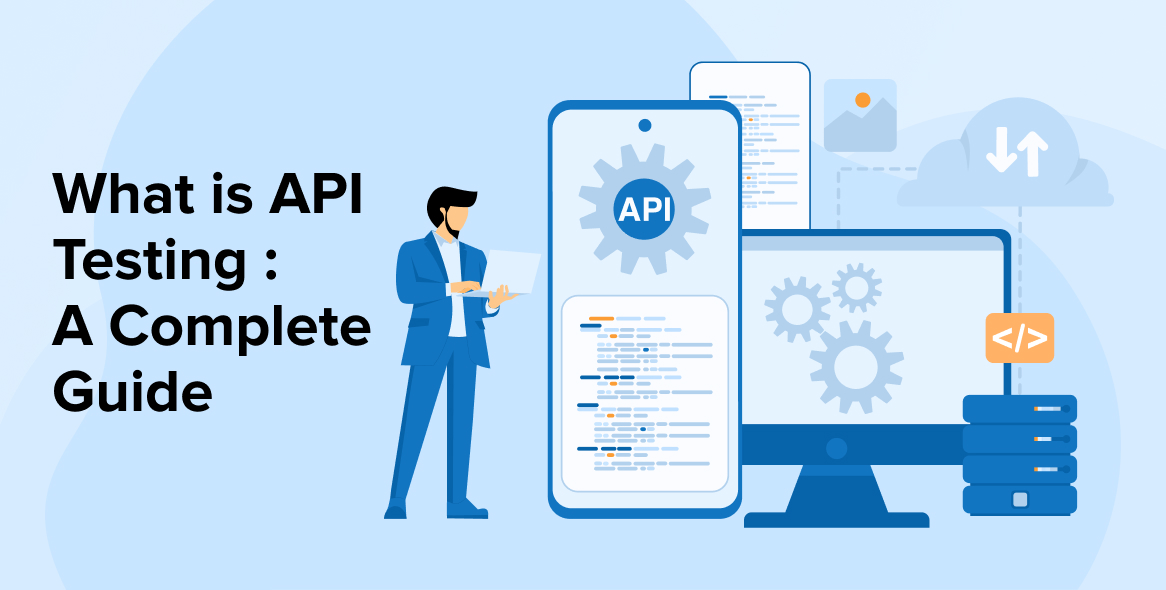
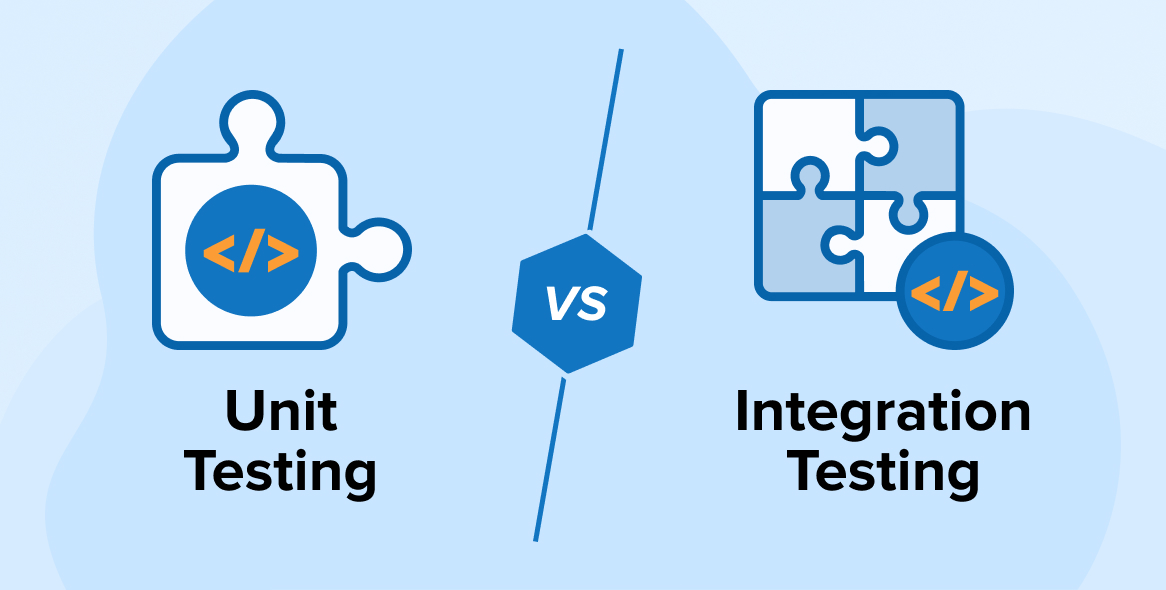
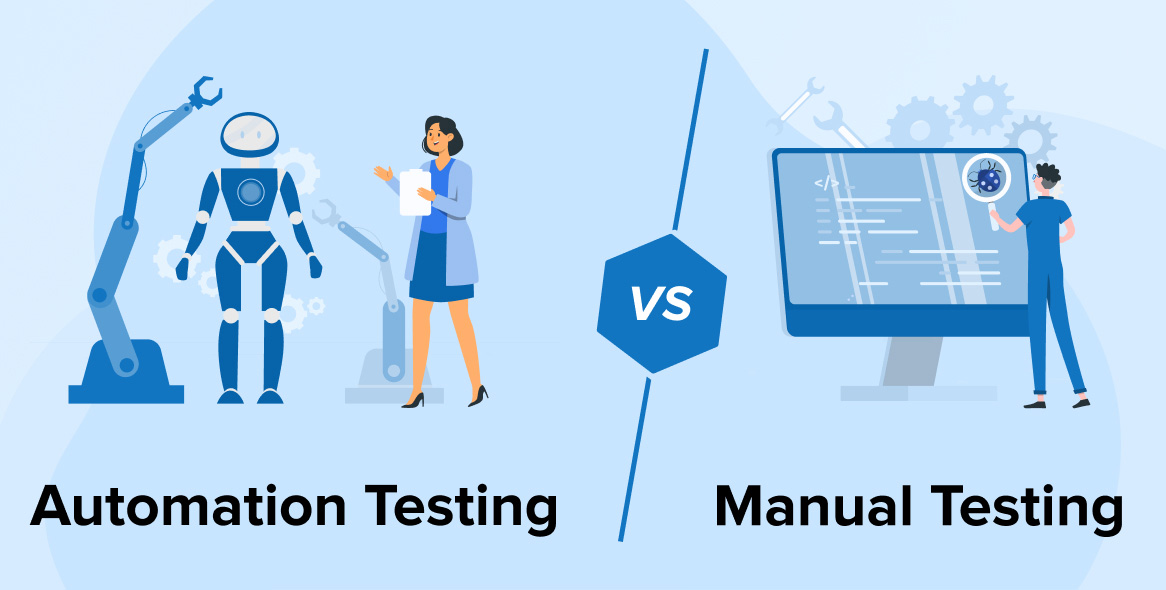

Comments
Leave a message...